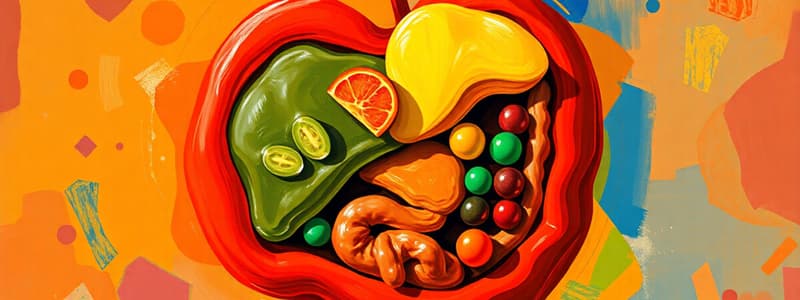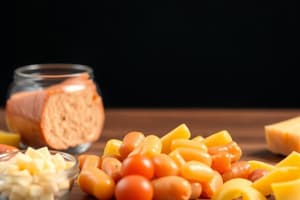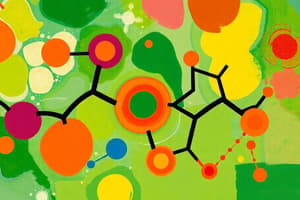Podcast
Questions and Answers
Which amino acids are specifically classified as ketogenic?
Which amino acids are specifically classified as ketogenic?
- Leucine and Lysine (correct)
- Glutamine and Methionine
- Valine and Histidine
- Threonine and Isoleucine
Which reaction is catalyzed by glutamate-pyruvate aminotransferase?
Which reaction is catalyzed by glutamate-pyruvate aminotransferase?
- Alanine to Pyruvate (correct)
- Glutamine to Glutamate
- Glutamate to a-Ketoglutarate
- Aspartate to Oxaloacetate
What is the primary site for urea formation in the body?
What is the primary site for urea formation in the body?
- Liver (correct)
- Pancreas
- Kidneys
- Intestines
Which of the following pairs describe essential amino acids in humans?
Which of the following pairs describe essential amino acids in humans?
What is a function of the pyridoxal phosphate (PLP) in transaminations?
What is a function of the pyridoxal phosphate (PLP) in transaminations?
What is the role of Monoamine Oxidase (MAO) in the metabolism of neurotransmitters?
What is the role of Monoamine Oxidase (MAO) in the metabolism of neurotransmitters?
Which metabolites are primarily involved in the urea cycle?
Which metabolites are primarily involved in the urea cycle?
Which MAO inhibitor is mentioned as useful in treating depression?
Which MAO inhibitor is mentioned as useful in treating depression?
What role do aminotransferases play in amino acid metabolism?
What role do aminotransferases play in amino acid metabolism?
What is the significance of tyramine in relation to MAO and blood pressure?
What is the significance of tyramine in relation to MAO and blood pressure?
Which amino acids can be formed from α-ketoglutarate through transamination?
Which amino acids can be formed from α-ketoglutarate through transamination?
Which of the following metabolites is produced from the metabolism of norepinephrine?
Which of the following metabolites is produced from the metabolism of norepinephrine?
Where is Monoamine Oxidase (MAO) primarily located within the cell?
Where is Monoamine Oxidase (MAO) primarily located within the cell?
What role does nitric oxide play in the vascular system?
What role does nitric oxide play in the vascular system?
What is the primary consequence of congestive heart failure on kidney function?
What is the primary consequence of congestive heart failure on kidney function?
Which substance is synthesized from arginine through a reaction involving nitric oxide synthase?
Which substance is synthesized from arginine through a reaction involving nitric oxide synthase?
In the conversion of serine to glycine, which enzyme is known to catalyze the reaction?
In the conversion of serine to glycine, which enzyme is known to catalyze the reaction?
What physiological function is sarcosine being investigated for in relation to prostate health?
What physiological function is sarcosine being investigated for in relation to prostate health?
What is the effect of sildenafil on nitric oxide’s function in the vascular system?
What is the effect of sildenafil on nitric oxide’s function in the vascular system?
Which of the following amino acids is formed directly from 3-phosphoserine in the conversion process?
Which of the following amino acids is formed directly from 3-phosphoserine in the conversion process?
What physiological event is primarily induced by the activation of guanylyl cyclase by nitric oxide?
What physiological event is primarily induced by the activation of guanylyl cyclase by nitric oxide?
What kind of obstruction can lead to an increased blood urea nitrogen (BUN) level?
What kind of obstruction can lead to an increased blood urea nitrogen (BUN) level?
Which pathway is serine a key intermediate in the biosynthesis of?
Which pathway is serine a key intermediate in the biosynthesis of?
What condition is characterized by a deficiency of cystathionine b-synthase?
What condition is characterized by a deficiency of cystathionine b-synthase?
Which compound is formed by the decarboxylation of S-Adenosyl methionine (SAM)?
Which compound is formed by the decarboxylation of S-Adenosyl methionine (SAM)?
What dietary element could enhance the conversion of homocysteine to methionine?
What dietary element could enhance the conversion of homocysteine to methionine?
What role do polyamines like spermidine and spermine play in the cell?
What role do polyamines like spermidine and spermine play in the cell?
Which of the following is a consequence of elevated homocysteine levels?
Which of the following is a consequence of elevated homocysteine levels?
What enzyme is responsible for converting histidine into histamine?
What enzyme is responsible for converting histidine into histamine?
What is the primary use of creatine supplementation?
What is the primary use of creatine supplementation?
Which substance is primarily used to assess kidney function through the creatinine clearance test?
Which substance is primarily used to assess kidney function through the creatinine clearance test?
Which of the following statements is true regarding phenylketonuria (PKU)?
Which of the following statements is true regarding phenylketonuria (PKU)?
What component is essential for the function of S-Adenosylmethionine synthase in methionine metabolism?
What component is essential for the function of S-Adenosylmethionine synthase in methionine metabolism?
What is the main dietary recommendation for individuals requiring treatment for a certain condition related to phenylalanine?
What is the main dietary recommendation for individuals requiring treatment for a certain condition related to phenylalanine?
Which compound is NOT a neurotransmitter in the catecholamine biosynthesis pathway?
Which compound is NOT a neurotransmitter in the catecholamine biosynthesis pathway?
What is the function of tyrosine hydroxylase in catecholamine biosynthesis?
What is the function of tyrosine hydroxylase in catecholamine biosynthesis?
What is a characteristic feature of phenylketonuria (PKU) treatment protocols?
What is a characteristic feature of phenylketonuria (PKU) treatment protocols?
Which chemical is used in Parkinson's disease treatment to increase dopamine in the brain?
Which chemical is used in Parkinson's disease treatment to increase dopamine in the brain?
Which of the following correctly identifies a compound that plays a role in catecholamine biosynthesis?
Which of the following correctly identifies a compound that plays a role in catecholamine biosynthesis?
Which enzyme is responsible for decarboxylating DOPA to produce dopamine?
Which enzyme is responsible for decarboxylating DOPA to produce dopamine?
In what way does carbidopa support the treatment of Parkinson's disease?
In what way does carbidopa support the treatment of Parkinson's disease?
Which of the following substances is an end product of catecholamine biosynthesis?
Which of the following substances is an end product of catecholamine biosynthesis?
What is the primary adverse effect associated with high levels of phenylalanine during development?
What is the primary adverse effect associated with high levels of phenylalanine during development?
Flashcards are hidden until you start studying
Study Notes
Protein Digestion
- Dietary proteins are broken down into amino acids during digestion.
- Begins in the stomach with pepsinogen converted to pepsin by acidic environment.
- Continues in the small intestine where pancreatic enzymes, trypsin, chymotrypsin, elastase, and carboxypeptidase are involved.
- Aminopeptidases from intestinal epithelia also assist in the breakdown of proteins.
Amino Acid Absorption
- Amino acids and oligopeptides are absorbed into the bloodstream from the small intestine lumen.
- Oligopeptides are broken down into amino acids by peptidases within the intestinal cells.
- Amino acids are transported in the bloodstream to various cells for protein synthesis and other metabolic processes.
Nitrogen Incorporation
- Ammonia is incorporated into organic compounds through various reactions:
- Carbamoyl phosphate is formed from ammonia, bicarbonate, and ATP by carbamoyl phosphate synthase I (CPS-I) in the mitochondria.
- Glutamate accepts ammonia to form glutamine through glutamine synthetase.
- Glutamate donates its amino group to other compounds in synthesis of purines, pyrimidines, and other amino acids.
Biosynthesis of Amino Acids
- Transamination is a key process in synthesizing amino acids.
- Ammonia acts as an intermediate in the process.
- A-ketoglutarate and Glutamate are essential to this process.
- Transaminases are enzymes that catalyze this reaction.
- They are important indicators of liver disease, elevated levels are observed in cases of liver damage.
Metabolic Classification of Amino Acids
- Essential amino acids cannot be synthesized in the human body.
- Arginine (essential in children but not adults), histidine, isoleucine, leucine, lysine, methionine, phenylalanine, threonine, tryptophan, and valine.
- Non-essential amino acids can be synthesized in the human body.
- Alanine, asparagine, aspartate, cysteine, glutamate, glutamine, glycine, proline, serine, and tyrosine.
- Glucogenic amino acids can be metabolized to glucose via pyruvate, oxaloacetate, a-ketoglutarate, fumarate, or succinyl CoA.
- Alanine, asparagine, aspartate, arginine, cysteine, glutamate, glutamine, glycine, histidine, isoleucine, methionine, phenylalanine, proline, serine, threonine, tryptophan, and valine.
- Ketogenic amino acids can be metabolized to acetyl CoA or acetoacetyl CoA.
- Isoleucine, leucine (solely ketogenic), lysine (solely ketogenic), phenylalanine, threonine, tryptophan and tyrosine.
Amino Acids Formed From a-Ketoglutarate
- Proline and Ornithine are formed from a-ketoglutarate through a series of enzymatic steps.
- Ornithine is key to the urea cycle (discussed in separate points).
GABA Formation
- Glutamate is decarboxylated to Gamma-aminobutyrate (GABA) by glutamate decarboxylase.
- GABA is an important inhibitory neurotransmitter in the brain.
Urea Cycle
- The urea cycle removes excess nitrogen from the body in the form of urea.
- Occurs primarily in the liver.
- Key steps:
- Ornithine is converted to citrulline.
- Citrulline is converted to argininosuccinate.
- Argininosuccinate is converted to arginine and fumarate.
- Arginine is converted to urea and ornithine.
- Ureogenesis is essential as high levels of ammonia in the blood are toxic.
- Can lead to brain damage.
- Treatment involves limiting protein intake and administering drugs that remove ammonia from the body.
Blood Urea Nitrogen (BUN)
- BUN is a measure of nitrogen in the blood.
- Elevated BUN levels are typically observed in:
- Amino acid catabolism
- Renal insufficiency
- Decreased BUN levels are observed in hepatic failure.
Synthesis of Nitric Oxide
- NO (nitric oxide) is synthesized from arginine by nitric oxide synthase (NOS).
- Citrulline acts as a product and intermediate.
Nitric Oxide Function
- Nitric oxide (NO) is a crucial vasodilator.
- Acts via the activation of guanylyl cyclase and production of cGMP, which leads to smooth muscle relaxation.
- Its functions are diverse:
- Plays a role in various physiological processes, including vasodilation, neurotransmission, and immune response.
Serine Synthesis
- Serine is synthesized from 3-phosphoglycerate via a series of steps.
- Begins with the glyceraldehyde-3-phosphate from glycolysis.
- Amination of hydroxypyruvate leads to serine.
Conversion of Serine to Glycine
- Serine is converted to glycine through serine hydroxymethyltransferase.
- Requires tetrahydrofolate (FH4).
- N5, N10-Methylene FH4 is a crucial intermediate in this reaction and is also used in the biosynthesis of purines and the formation of thymine, which impacts DNA synthesis.
Sarcosine (N-Methylglycine)
- Sarcosine is formed from glycine by glycine N-methyltransferase, requiring S-Adenosyl methionine as a methyl donor.
- Potential biomarker for prostate cancer.
Sulfur-Containing Amino Acids
- Methionine is the precursor to cysteine.
- Requires vitamin B6 (pyridoxine).
Homocysteine Metabolism
- Homocysteine is a sulfur-containing amino acid.
- High blood levels of homocysteine are linked to cardiovascular disease.
- Homocysteinuria is a rare genetic disorder caused by a deficiency in cystathionine β-synthase.
- Symptoms of homocysteinuria include dislocated optical lenses, mental retardation, osteoporosis, cardiovascular disease, and death.
- Folate enhances the conversion of homocysteine to methionine.
- Dietary folate deficiency may contribute to high homocysteine levels.
Methionine Metabolism
- Methionine is an essential amino acid, meaning it cannot be synthesized by the body and must be obtained from the diet.
- Methionine is a precursor to SAM (S-adenosyl methionine).
- SAM is a methyl donor in many metabolic reactions.
- Polyamines (spermidine and spermine) are essential for growth and cell division.
- Polyamine synthesis is inhibited by α-difluoromethylornithine (DFMO) and eflornithine.
- DFMO is used to treat Pneumocystis carinii infections.
Creatine and Creatinine
- Creatine is a nitrogenous compound synthesized in the liver and kidneys.
- Creatine is a dietary supplement used to improve athletic performance.
- Creatinine is a waste product of creatine metabolism and is excreted in the urine.
- Creatinine clearance test is used to assess kidney function.
- Creatinine levels in urine are proportional to muscle mass.
Histidine Metabolism
- Histidine is an amino acid that is a precursor to histamine.
- Histidine decarboxylase converts histidine to histamine.
- Histamine is a mediator of allergic responses and stimulates gastric acid secretion.
- H1 blockers (diphenhydramine, loratidine) are used to block the effects of histamine on allergic reactions.
- H2 blockers (cimetidine, ranitidine) are used to block the effects of histamine on gastric acid secretion.
Phenylalanine and Tyrosine Metabolism
- Phenylalanine is an essential amino acid.
- Tyrosine is a non-essential amino acid.
- Phenylalanine hydroxylase converts phenylalanine to tyrosine.
- Tetrahydrobiopterin (BH4) is a cofactor for phenylalanine hydroxylase.
- Phenylketonuria (PKU) is a genetic disorder characterized by a deficiency in phenylalanine hydroxylase.
- Treatment for PKU involves limiting phenylalanine intake.
Catecholamine Biosynthesis
- Catecholamines (dopamine, norepinephrine, epinephrine) are neurotransmitters that are synthesized from tyrosine.
- Tyrosine hydroxylase converts tyrosine to dihydroxyphenylalanine (DOPA).
- DOPA decarboxylase converts DOPA to dopamine.
- Dopamine hydroxylase converts dopamine to norepinephrine.
- Phenylethanolamine N-methyltransferase converts norepinephrine to epinephrine.
Parkinson's Disease
- Parkinson's disease is characterized by loss of dopamine-producing neurons in the basal ganglia.
- L-DOPA is a precursor to dopamine and is used to treat Parkinson's disease.
- Carbidopa is used in conjunction with L-DOPA to prevent its breakdown in the periphery.
- L-DOPA does not cross the blood-brain barrier, and Carbidopa prevents its breakdown in the periphery, thereby increasing the amount of L-DOPA available to the brain.
Monoamine Oxidase
- MAO (monoamine oxidase) is an enzyme that breaks down catecholamines and other neurotransmitters.
- MAO inhibitors are used in the treatment of depression.
Tyramine
- Tyramine is an amino acid that is found in several foods, including cheese, beer, and red wine.
- Tyramine is a substrate for MAO.
- High levels of tyramine can lead to hypertensive crisis in individuals taking MAO inhibitors.
Studying That Suits You
Use AI to generate personalized quizzes and flashcards to suit your learning preferences.




